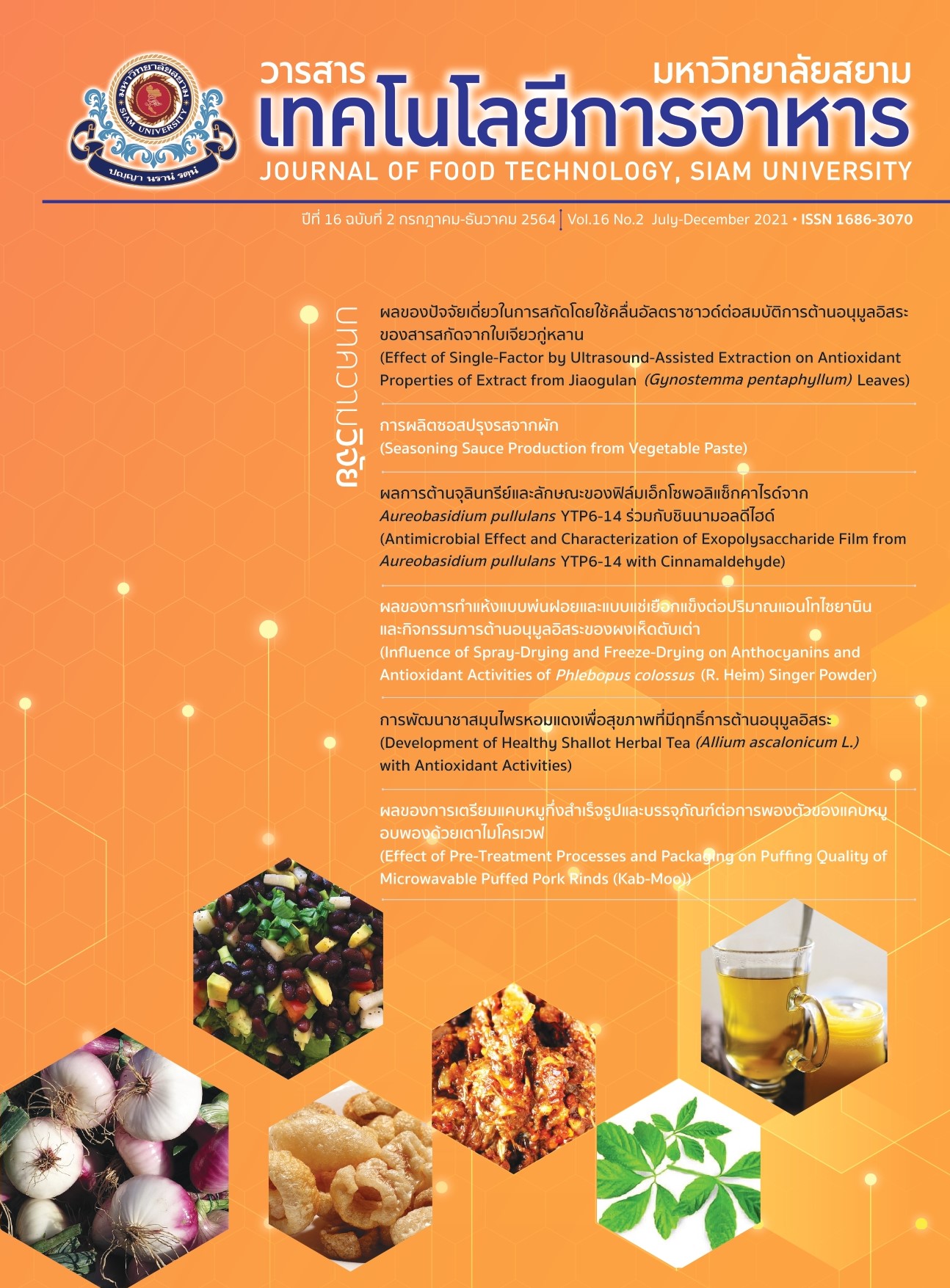การผลิตซอสปรุงรสจากผัก
Main Article Content
บทคัดย่อ
น้ำผักเป็นผลิตภัณฑ์อาหารพื้นบ้านของอำเภอแจ้ห่มจังหวัดลำปาง ซึ่งทำจากผักกาดเขียว นิยมบริโภคกันอย่างแพร่หลายในพื้นที่ภาคเหนือตอนบน เนื่องจากมีรสชาติและคุณค่าทางโภชนาการสูง การศึกษานี้มีวัตถุประสงค์เพื่อนำน้ำผักมาทำเป็นซอสปรุงรสเพื่อเพิ่มมูลค่าของผลิตภัณฑ์ในท้องถิ่น โดยการนำน้ำผักมาเจือจางด้วยน้ำอัตราส่วน 60:40 (น้ำผัก:น้ำ) และพัฒนาสูตรโดยใช้การทดลองออกแบบส่วนผสม พบว่าสูตรซอสปรุงรสจากผักที่มีคะแนนการประเมินทางประสาทสัมผัสสูงสุดประกอบด้วย น้ำผักเจือจาง 65 wt% แป้งข้าวโพด 5 wt% น้ำตาลอ้อย 30 wt% เกลือ 4 wt% และพริกไทย 8 wt% โดยสภาวะในการพาสเจอร์ไรส์ที่เหมาะสมคือ 93.3ºC เป็นเวลา 20 นาที ซอสปรุงรสจากผักที่ได้มีองค์ประกอบทางเคมีคือ โปรตีน 3.66% ไขมัน 15.04% เถ้า 13.20% เส้นใย 3.32% ปริมาณคาร์โบไฮเดรต 24.46% และกรดอะมิโนอิสระ 14 ชนิด วิเคราะห์โดย High Performance Liquid Chromatography (HPLC) มีปริมาณกรดทั้งหมดและ pH เท่ากับ 0.74% และ 3.35 ตามลำดับ ปริมาณจุลินทรีย์ทั้งหมด 3.0x102 CFU/g ตรวจไม่พบโคลิฟอร์มแบคทีเรีย ยีสต์ และรา ซึ่งค่าที่ได้เป็นไปตามค่ามาตรฐานของซอส (มอก.1317-2538)
Article Details
บทความทุกบทความในวารสารเทคโนโลยีการอาหาร ทั้งในรูปแบบสิ่งพิมพ์ และในระบบออนไลน์ ถือเป็นลิขสิทธิ์ของมหาวิทยาลัยสยาม และได้รับการคุ้มครองตามกฎหมาย
เอกสารอ้างอิง
Liu, J., Liu, M., He, C., Song, H. and Chen, F. (2015). Effect of thermal treatment on the flavor generation from maillard reaction of xylose and chicken peptide. LWT‐Food Science and Technology. 64(1): 316–325.
A.O.A.C. (2000). Official methods of analysis of AOAC. International. 27thed. Association of Official Analytical Chemists. Arlington, Virginia.
Henderson, J.W., Ricker, R.D., Bidlingmeyer, B.A. and Woodward, C. (2000). Agilent technical Note 5980-1193E.
BAM (Bacteriological Analytical Manual) Online. (2001). Chapter 3: aerobic plate count. USFDA.10pp. [Online] Available from http://www.cfsan.fda.gov. [Accessed May, 19, 2020]
Meilgaard, M.C., Civille, G.V. and Carr, B.T. (2007). Sensory evaluation techniques, 4th ed, CRC Press, Taylor and Francis Group, USA.
BAM (Bacteriological Analytical Manual) Online. (2002). Chapter 4: Enumeration of Escherichia coli and the coliform bacteria. USFDA. 10 pp. [Online] Available from http://www.cfsan.fda.gov. [Accessed May, 19, 2020]
Sun, H.; Liu, F.; Sun, L.; Liu, J.; Wang, M.; Chen, X.; Xu, X.; Ma, R.; Feng, K.; Jiang, R. Proteomic analysis of amino acid metabolism differences between wild and cultivated Panax ginseng. Journal of Ginseng Research 2016. 40: 113–120.
Notification of the Ministry of Public Health (No. 201). (2000). Some Particular Kinds of Sauces. Government Gazette Vol. 118, Special Part 6 Ngor, dated 24th January 2001). [Online] Available from http:// food.fda.moph.go.th/law/datath/law/data/annou/P201.pdf. [Accessed October, 10, 2020]
Rahman, M.N.A. and Thajudin, N.A.M. (2015).Product development of kembayau (Canarium odontophyllum) exotic fruit sauce. Journal of Tropical Resources and Sustainable Science, 3: 19-28.
Borroto‐Escuela, D.O., Tarakanov, A.O., Brito, I., and Fuxe, K. (2018). Glutamate heteroreceptor complexes in the brain. Pharmacological Reports. 70(5): 936–950. doi.org/10.1016/j.pharep. 2018.04.002


